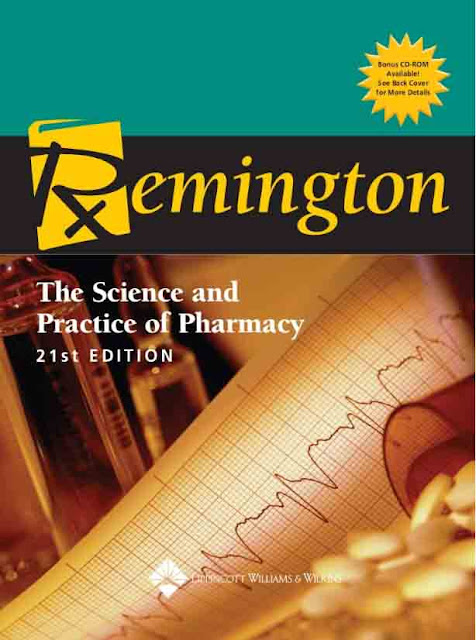in Remington The Science and Practice of Pharmacy 21th Edition's Book has added more than 100 new drug monographs, and the previously existing material has been updated. We realize that this is a section that is nearly impossible to keep current, and we’ve tried to include as many new drugs as possible.
About New Edition
In this new edition, you will find a text focused on
practice while maintaining reliable traditional coverage of aspects of science.
The 21st edition follows changes in the curriculum for pharmacy and
professional pharmaceutical practice in general.
Many changes have taken place in the field of pharmacy and
pharmaceutical practice since the first publication of Remington's
Pharmaceutical Sciences. Although this edition of Remington retains the general
philosophy of previous editions, many changes have been made to present new and
innovative information and to take advantage of the progress made in recent
years. Each part of the book has been critically reviewed and adjusted to
reflect evolving industry trends. The general organization of the book is the
same as in previous editions.
The biggest change in the 21st year is in the Pharmacy
Practice section. This section has been reorganized and expanded to reflect the
changing realities of current practice. Integrating new scientific information
into clinical practice is often difficult, and one of the main goals of this
section is to help clients translate this scientific advancement into clinical
practice and patient care. This section brings readers the latest trends and
trends. New chapters have been added that share:
• The
application of ethical principles to practice dilemmas
• Statistics
applied to pharmacy practice
• Technology
and automation
• Professional
communication
• Medication
errors
• Re-engineering
pharmacy practice
• Management
of special risk medicines
• Specialization
of pharmacy practice
• Disease
state management
• Emergency
patient care
• Wound
care
Metrology and Pharmaceutical Calculations
One of the first technical operations to learn Phar-Macy students is the manipulation of balances, weights, and volume size. This requires a study of various weight systems and steps, their relationship, and mastery of mathematics involved. This chapter considers the principles of the underlying mental mentality micrology of testing, manufacturing, and compounding pharmaceutical preparation:
Weights and steps - accumulated facts about various systems, with conversion factor tables and factory equiva-lents. Relationships among various systems weights and mea-sures are clarified.
Colloidal Dispersions
British chemist Thomas Graham applies the term "colloid" (comes from the Greek word for glue) CA 1850 to polypeptides such as albumin and gelatin; polysaccharides such as Acacia, Pati, and Dextrin; And inorganic compounds such as Hydroxides Metal Gelati-Nous and Prussia Blue (Ferric Ferrocyanide). Contemporary colloids and surface chemicals are related to unusual various industrial and biological systems. Some examples include catalysts, lubricants, adhesives, latex for paint, rubber, and plastic, soap and detergent, clay, ink, film packaging, cigarette smoke, liquid crystal, drug delivery system, mucous membrane, and aque-humor OUS.
Biological testing includes quantitative testing drugs with biological methods and the application of qualitative bio-logical tests. The test uses intact animals, animal preparations, networks and cells of life isolated, or microorganisms. In addition to drugs, biological tests are requirements for plastic that will be used as a container or closure for ophthalmic and par-enteral preparation or for use as implants, devices, or other related systems.
USP's practice is a good index of bi-ological testing conditions. At present there are trends to use less Ani-males in research and biological research and use alternatives such as cells and microorganisms in culture. The decline in the use of these animals can be observed in decreasing requirements for animal testing by USP as documented in their mono chart. If possible, in vitro procedures must be used to complement or replace Vivo tests to evaluate plastic capabilities.
The majority of therapeutic agents available today are known chemical composition agents that can be tested by quantitative chemical or physical analysis. However, there are a number of useful drugs that cannot be tested satisfactorily by chemical or physical ways. These drugs, which mainly come from nature, are tested by biological seals. Biological standardization procedures are generally not appropriate, more time consuming, and more expensive to do than chemical tests; Therefore, they are generally served back for use:
Book is available in Software & Pdf
PDF Version
Click on the following Download in pdf:
Software Version
Here is some screenshot of Remington The Science and Practice of Pharmacy software book
Click on the following Download in software:





.webp)
%20Web%20of%20pharma%20.webp)




%20webofpharma.JPG)



